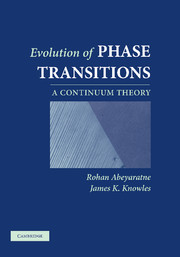Book contents
- Frontmatter
- Contents
- Preface
- Part I Introduction
- Part II Purely Mechanical Theory
- 2 Two-Well Potentials, Governing Equations and Energetics
- 3 Equilibrium Phase Mixtures and Quasistatic Processes
- 4 Impact-Induced Transitions in Two-Phase Elastic Materials
- Part III Thermomechanical Theory
- Part IV One-Dimensional Thermoelastic Theory and Problems
- Part V Higher Dimensional Problems
- Author Index
- Subject Index
3 - Equilibrium Phase Mixtures and Quasistatic Processes
Published online by Cambridge University Press: 12 August 2009
- Frontmatter
- Contents
- Preface
- Part I Introduction
- Part II Purely Mechanical Theory
- 2 Two-Well Potentials, Governing Equations and Energetics
- 3 Equilibrium Phase Mixtures and Quasistatic Processes
- 4 Impact-Induced Transitions in Two-Phase Elastic Materials
- Part III Thermomechanical Theory
- Part IV One-Dimensional Thermoelastic Theory and Problems
- Part V Higher Dimensional Problems
- Author Index
- Subject Index
Summary
Introduction
In the present chapter we study the equilibrium and quasistatic response of a thin bar composed of a material modeled by the stress–strain curve shown in Figure 2.2 of the preceding chapter. There is an extensive experimental literature devoted to tensile loading and unloading of bars made of materials that are capable of undergoing displacive phase transitions; often the materials studied are technologically important shape-memory alloys such as nickel–titanium. For a small sample of this literature, the reader might consult the papers of Krishnan and Brown [13], Nakanishi [17], Shaw and Kyriakides [19], and Lin et al. [14], as well as the references cited there. The loading in such experiments is slow, in the sense that inertia is insignificant. The objective is typically the determination of the relation between the applied stress and the overall elongation of the bar, though in some studies, such as that of Shaw and Kyriakides [19], local strain and temperature measurements are made as well. The stress–elongation relation that is observed in such experiments exhibits hysteresis, the phase transition being the primary mechanism responsible for such dissipative behavior. For a given material, the size and other qualitative features of the hysteresis loops depend on the loading rate and the temperature at which the test takes place. In the model to be discussed in this chapter, thermal effects are omitted; they will be accounted for in later chapters.
- Type
- Chapter
- Information
- Evolution of Phase TransitionsA Continuum Theory, pp. 32 - 58Publisher: Cambridge University PressPrint publication year: 2006



